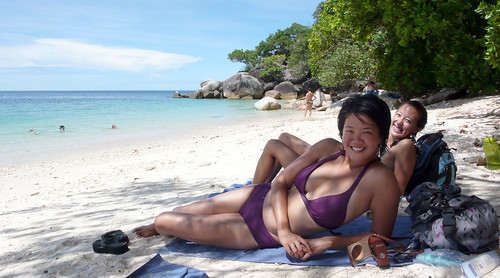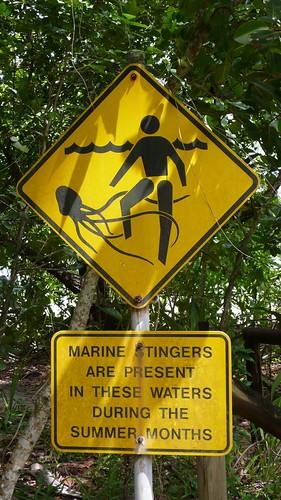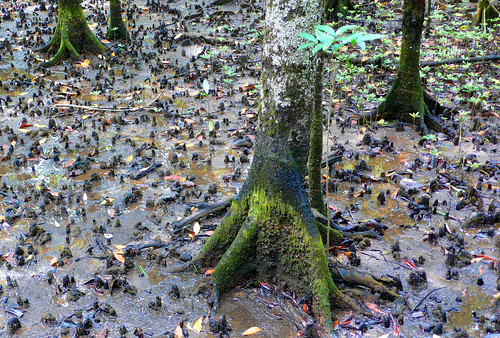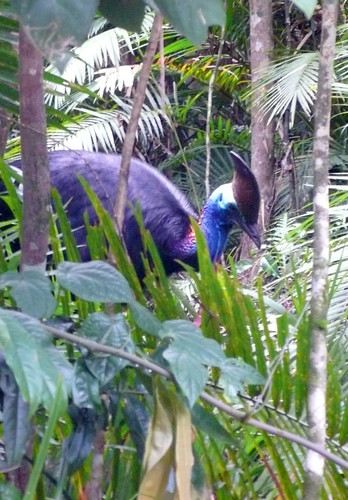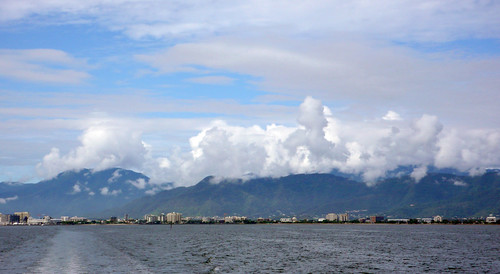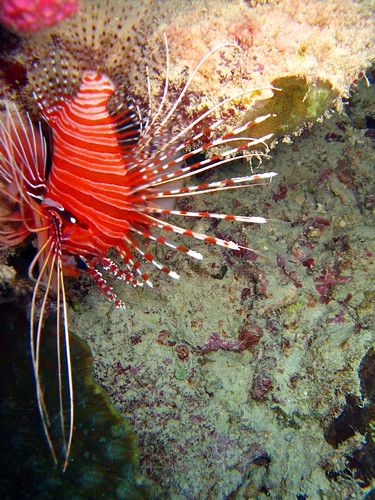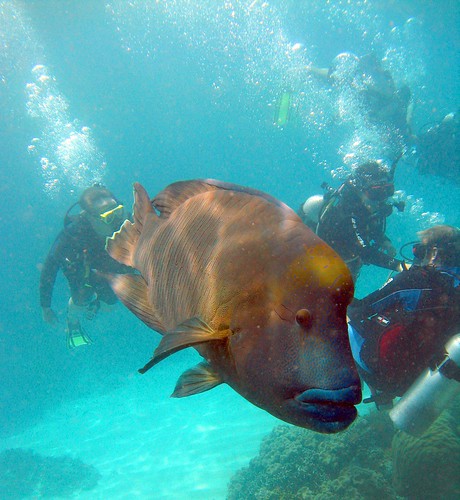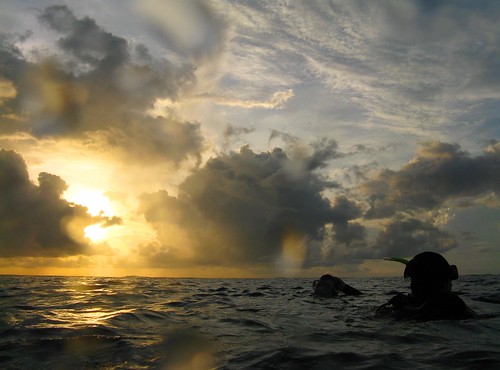Posts Tagged ‘Queensland’
When we got off the OceanQuest II, we were very tired and more than a bit messed up from all the diving we did (clogged ears and blistered feet from the bad rental fins), but happy and looking forward to our the next part of our Cairns trip: a visit from my cousin Jasmine! Jasmine is in grad school in Brisbane, so she bought a plane ticket into Cairns to share a few days with us on our trip. We’ve met a lot of really nice people, but there’s nothing like seeing a familiar face while you’re traveling…and family at that! ![]()
Diving is by far the biggest tourist attraction in Cairns, but you can also hop around to some of the offshore islands via ferry. We chose Fitzroy Island, because we read that Green Island was more touristed and Fitzroy attracted more locals. The ferry to Fitzroy costs about AUD$63 return (approx. US$48), and it takes about an hour to get to the island. There are a few small beaches and one resort there, where you can rent snorkeling gear and stinger suits: ridiculous-looking full-body swimsuits that prevent you from being stung by the deadly jellyfish in the water.
After putting on the suits, your fins, and snorkel mask, the only skin exposed is on your forehead and around your mouth…and you still get stung around your lips (though only by harmless but stingy jellyfish and not the super deadly kind). We were both a little freaked out by this but once the current came up in the afternoon, it washed all the stingers away and you could get in the water without the Blue Man suit on.
It was a really lovely island and we spent the day relaxing on the beach, snorkeling, and checking out the new resort they just built on the island.
The following day, we rented a car and drove up towards Cape Tribulation, which the brochures describe as a place where “the rainforest meets the reef.” One thing I haven’t mentioned about Cairns: it’s hot. And wet. Like, 90 degrees hot and 100% humidity wet. Also, remember the deadly jellyfish? If not, there are helpful signs everywhere to remind you:
All you want to do is jump in the water when it’s this hot and wet, but you can’t because of the deadly jellyfish, and oh yeah, did I mention there are crocodiles here too?
All of this makes Cape Tribulation a bit boring, since you can’t really swim or walk on the beach and there isn’t really much else out there. BUT, we did do a “boardwalk” (literally, a boarded walkway) through a mangrove forest. And this was actually really cool because it turns out that Jasmine is some sort of mangrove expert and could totally be a mangrove tour guide if there was such a thing and she decided that life as a grad student wasn’t for her. She told us all these cool facts about mangroves, like the fact that the long pods that hang off the tree are actually mangrove seedlings that have already germinated, so they just fall off the tree, float in the water until they hit land, and immediately take root.

Seedlings hanging off a mangrove tree.
Mangroves also send up root stubs above the ground in order to get more air, like little snorkels:
We also spotted a cassowary! In case you don’t know what a cassowary is (I didn’t), it’s an enormous bird like looks kind of like a ostrich or emu, except its body is covered in black fur, and its head looks like a psychedelic turkey. They are weird, but super cool looking animals.
Mostly though, we just spent the time seeing some stuff around Cairns and getting to know Jasmine a bit better. Jasmine and I grew up together in San Diego and our families are really tight, but we really haven’t spent much time together as adults, and it was really cool to see the interesting human she has become. Thanks for coming to visit us, Jasmo! We had a great time with you and really appreciate you spending the time and money to come see us on our trip. xox
Cairns is on the northeastern side of Australia, in Queensland (apparently the only state where people actually say “crikey,” though we never heard any Aussies use this phrase). Cairns the city isn’t much to write home about, but it acts as a launching pad for the Great Barrier Reef. The GBR is unusual, first, for its size (huge), and secondly, for the fact that it exists so far away from the coast (usually, reef systems develop fairly close to the shore). As a result, to get the best diving experience in the GBR, you must stay on a liveaboard boat. You can do a day boat out to the reef, but you will spend most of your time in transit (it takes an hour on a motorboat just to get out to the reef) instead of doing what you really want to do, which is diving.
We did a 3 day/2 night excursion with Deep Sea Divers Den, one of the larger GBR touring operations (the other is ProDive). It is a large boat, with room for 48 people, but the boat was not at capacity since this is the low season in Cairns due to tropical storming (Aussies call it “the wet,” and indeed, it apparently stormed really hard the day before we flew into Cairns, as the surrounding plains were completely flooded). We had tried for a smaller boat—the Santa Maria is smaller sailing vessels that maxes out at 10 people per trip—but their leave dates did not work with our schedule. Nevertheless, DSDD is a great deal: a really nice double room, all food, and all gear for 12 dives costs AUD$560 (approx. US$420) per person. They do try to upsell you on a few things (guided and deep dives, a nicer flashlight for the night dives, etc.), which is annoying but I guess to be expected. The common areas on the boat are also really large and comfortable, so we never felt crowded or claustrophobic.
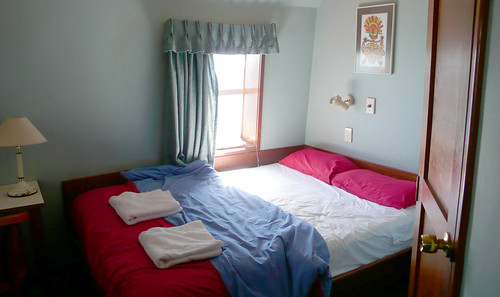
Our double room on the OceanQuest II.
So here’s how it works with DSDD: you board a day boat early on the first day (DSDD will pick you up from wherever you are staying, which is nice). This first boat is where you will do your first 3 dives. After lunch, people who are staying overnight get transferred over to the liveaboard (the OceanQuest II). The day boat includes certified divers, people taking their PADI courses, and snorkelers, and it is pure mayhem. The dive deck is small and crowded, and it is pretty chaotic and hectic when all these different groups are trying to get ready to get in the water. But that’s not the worst part—apparently half the people on this boat did not realize that they were prone to seasickness…until they got on the day boat. I’m not joking when I say that there were people throwing up everywhere you looked. As such, we started referring to the day boat as the “Barf Boat.”
Needless to say, we were pretty happy to be transferred over to the OceanQuest II, where things are much calmer, more spacious, and less..barfy.
OK, on to the diving. When we tell people that we dove the GBR, the first thing they ask is, “Is the reef really dying?” And the answer is, well, yes, parts of it are. But other parts of it are still really beautiful and pristine. On the OceanQuest II, we moved dive locations twice a day, but all locations seemed to be clustered around the same area. We are not sure if maybe Queensland makes the large boats stick to a certain part of the reef in order to minimize damage, or maybe divers are only allowed in certain areas. In any case, it seems that you move very short distances from one cove to the next when you dive with these liveaboard operations.
I don’t think we had the best dive conditions when we were there. The first day was pretty bad because the storm had stirred up a lot of stuff and visibility was pretty poor. But by the second day the visibility was a lot better—probably up to about 10 meters—though we heard that when it is good here, you can see 30 or more meters under water. The early morning dives were the absolute best conditions: the sun is just rising, the reef is waking up, and the visibility is excellent.
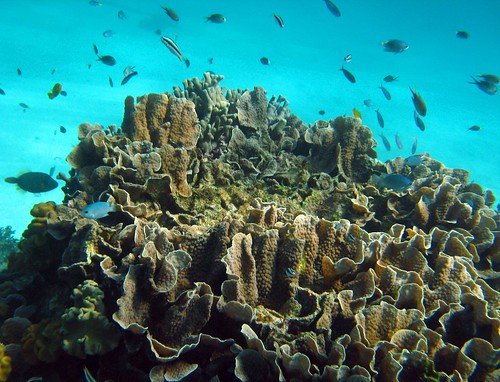
Coral system with lots of fishies.
We did 4 dives the first day, 5 dives the second, and 3 dives on the final day. That’s a lot of diving! I think I had only done about 10 or so dives before this and Jeremy had done 6, so with 12 more dives under our belts, we doubled and tripled our logged dives. It was a pretty intense schedule. On the second day we did the following:
6AM: Morning dive
7AM: Breakfast
9AM: Dive
11AM: Dive
12:30PM: Lunch
3PM: Dive
6PM: Dinner
7PM: Night dive
Oh, one thing to take note: all dives on this boat were unguided (you have to pay AUD$15 or US$12 for guided dives with DSDD). This was really unusual for us, as we have always been diving with a divemaster, but we came to really like the freedom of unguided diving. DSDD does a little dive brief beforehand to go over the dive area, and then you get thrown into the water.
We saw fabulous coral systems, a shark (Jeremy did, I didn’t), a guitar fish, giant clams, rays, turtles, and lots and lots of tropical fish. By far the star of the underwater show, however, was Wally, a giant Napoleon fish who is so tame we were calling him “the puppy dog of the sea.” Seriously, he would swim right up to you and let you pet him and everything.
The phrase “diving the Great Barrier Reef” elicits all sorts of fantastic thoughts in the imagination, and though we’re not sure that our experience met these very high expectations, we are really glad we did the trip. We mets many really fabulous people, did our first night dives, logged several more dives in our books, and overall had a really great experience…except for the barf boat. ![]()

